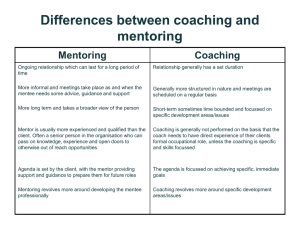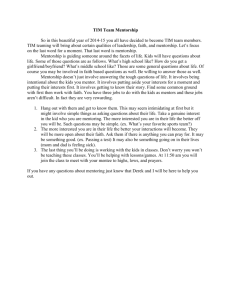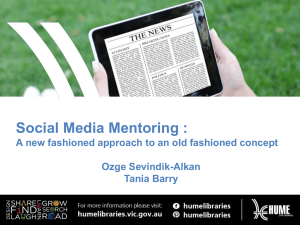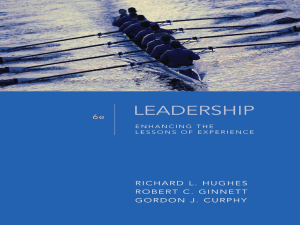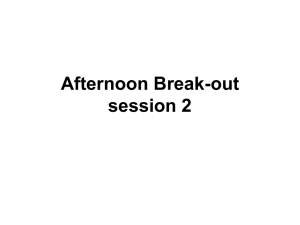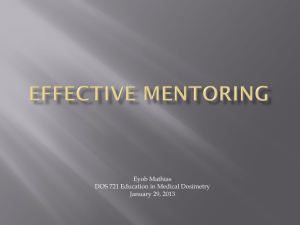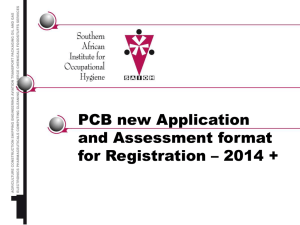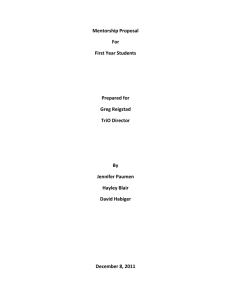Mentorship vs. Supervision: How You Can Be the Best for Your Staff
advertisement
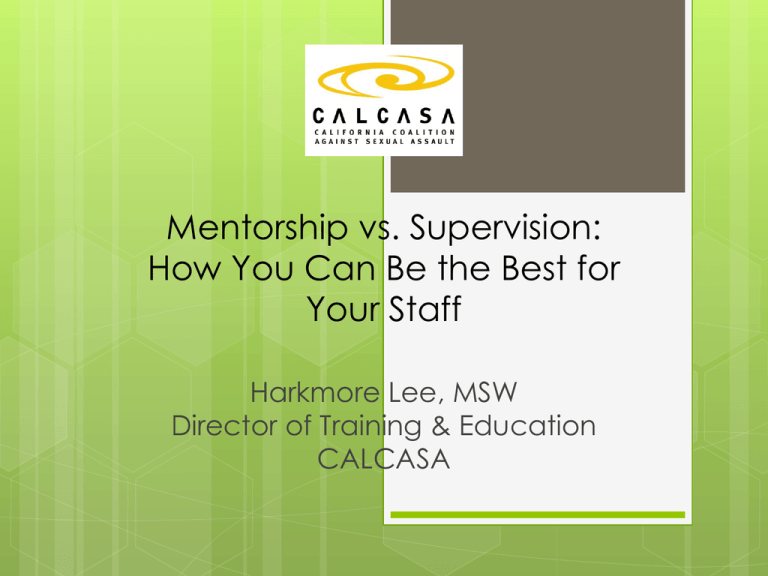
Mentorship vs. Supervision: How You Can Be the Best for Your Staff Harkmore Lee, MSW Director of Training & Education CALCASA Today’s Agenda 1) 2) 3) 4) 5) 6) 7) 8) Overview of workshop Group Agreements Learning Objectives Supervisions vs. Mentorship Benefits How to develop a mentoring/coaching approach Exercise Review Group Agreements ALL IDEAS AND POINTS OF VIEW HAVE VALUE You may hear something you do not agree with or you think is "silly" or "wrong." Please remember that one of the goals of this meeting is to share ideas. All ideas have value in this setting. Also share YOUR ideas and thoughts and avoid editorials of another colleague’s comments. SAFE SPACE What is shared and discussed with one another should “stay here” – apart from ideas and solutions that will help your own work and agency. USE COMMON CONVERSATIONAL COURTESY Please don't interrupt; use appropriate language, avoid third party/ side bar discussions, etc. Group Agreements HUMOR IS WELCOME BUT humor should never be at someone else's expense. HONOR TIME We have an ambitious agenda, so it will be important to follow the time guidelines for the next two days. CELL PHONE / TEXTING / E-MAIL COURTESY Please turn cell phones, or any other communication item with an on/off switch to “silent. If you need to respond, kindly step outside BE COMFORTABLE Please feel free to take personal breaks as needed ANY OTHERS AGREEMENTS TO ADD? Learning Objectives • To understand the difference between supervision and mentoring. • To learn the benefits of developing a mentoring / coaching approach towards those who you are responsible for on a day to day basis. • To learn how to develop a mentoring/coaching approach that will help those you supervise succeed. Supervision vs. Mentorship “Supervision” - to oversee a person or group of people engaged in an activity or task and keep order or ensure that she/he/they perform it correctly. “Mentorship” - A mentorship refers to relationship between an experienced professional and a less experienced mentee or protege. During the “mentorship” experience, it is common for a “mentee” to be matched with a "mentor" who will give them advice and help them succeed Today we still refer to a “mentor” as a wise individual: “An experienced and trusted adviser” (Oxford English Dictionary ) “A trusted counselor or guide, tutor, coach” (Merriam-Webster's Collegiate Dictionary ) Would those you supervise describe you in these terms? A mentoring approach is important to an organization because it: Encourages mutual loyalty between employee and employer. Increases employee retention. Helps new employees acclimate to job and company culture more quickly and increases their learning curve. Improves organizational performance. Increases employee productivity. Creates a greater sense of involvement in the organization and career. Increases employee morale. Supports innovative work environment. Increases creativity and exposure to new ideas. Contributes to the development of a cooperative, productive and service-oriented environment. A mentoring approach is important to a supervisor because it: Represents making a difference to the organization, profession and the staff member or volunteer. Provides the fulfillment and satisfaction of helping others. Gives “payback” for the support received from others in the past. Expands effective communication skills. Increases experience and skills for career development. Provides an opportunity to communicate corporate values. Creates a sense of team within work group. Creates work allies. A mentoring approach is important to a staff member or volunteer because it: Helps provide professional development. Demonstrates the employer recognition of knowledge, skills and abilities of the mentee. Usually helps to advance career more quickly. Increases confidence. Develops creative and independent thinking. Helps acclimate a new staff member to his or her job and company culture more quickly. Help off-site employees feel more in touch socially and professionally. Results in a greater awareness of organizational politics and culture. Provides an appreciation and effective use of networking. Develops proactive approaches to tasks and projects. Creates a movement toward “expert” status. What makes a good mentor? Active listening Role modelling Clear boundaries Analytical skills Honest feedback In the workplace, developing a mentoring approach first takes the form and role of a “coach.” In the role of coach, a partnership with an employee is developed in order to strengthen and expand the employee's skills in specific areas of job performance. Trust- the glue of all relationships. When we work in a climate of trust, we know that we can predict the positive actions and attitudes of another person. We know that she/he cares about us and support our efforts. Definitions Feedback- positive recognition of a job well done or the constructive criticism of a skill or task which could use improvement. Desired behaviors- the actions or skills that provide the most effective completion of a task. Replacement behaviors- new behaviors to replace ineffective or inappropriate behaviors. Effective employee “coaches” will: Establish a trusting relationship with all employees. Listen more than talk. Speak directly. Value and model continuous learning. Recognize their own limitations. Make an effort not to overuse strengths. Offer chances to take risks. Remain curious rather than defensive. Model accountability and ownership. Meet others where they are and help them move forward. Keep an optimistic attitude about people. Effective employee “coaches” will: Offer immediate positive recognition. Help others view mistakes as learning opportunities. Help employees work on one skill at a time. Smile! Meet individually with employees to identify ways to help them be more effective. Use common courtesies (please, thank you). Apologize for mistakes or for treating others without respect. Confront the issue, not the person. Demonstrate friendly, positive and upbeat behaviors to others. So how do I begin? Create a “coaching” or workplan plan for an employee with whom you work. 1. Determine the employee's strengths and weaknesses: • List job competencies, behaviors, or skills most important to success. • Compare the individual's observable performance with the desired behaviors. • List future skills that may be needed. 2. Invite the individual to self-assess according to competencies. 3. Discuss the plans for improvement or growth. 4. Identify the best situation for new learning to take place. So how do I begin? 5. Identify the best times for you to observe new behaviors. 6. Observe the employee and note what is effective and ineffective. 7. Provide immediate feedback with examples and describe replacement behaviors. 8. Model respect for the individual. Feedback with Meaning Positive Feedback Describe the behavior, such as producing a certain quantity in a set time. Explain the impact of the behavior for the person, the job, and the organization or team. Be clear in communicating what is effective or successful so it will continue. Give recognition for positive behavior. Feedback with Meaning Constructive Criticism Be specific and focus on the behavior, not the person. Describe the significance of behaviors for the team or team goals. Remain calm. Be selective in choosing only what a person can receive. Watch for non-verbal cues. Listen to the individual's perspective of the behavior and/or situation. Identify the benefits of improving the behavior. Balance positive and negative feedback. Exercise: 1. Think about a staff member or volunteer who you currently supervise or may be supervising. 2. Identify two behaviors or skills of that person that you value and see as a strength, as well as two more that you see as a weakness and should be improved upon. 3. Pair up in groups of 3 in the room. Introduce one another. Describe the strengths and weakness of the your staff member/volunteer to each another (but withhold the identity of that staff member/volunteer) Exercise: 4. Take one of the strengths and weaknesses and have your other two group members role play each strength and weakness. Then provide both positive feedback and constructive criticism 5. Discuss what the experience was like with each other. Supervisor’s Self-evaluation Select and list three personal changes you could make which could significantly increase your effectiveness as a mentoring/coaching manager: 1. 2. 3. Describe specific actions and appropriate times for you to implement these changes. Speak with your own supervisor to help you ensure your success. Explain your goals for self-change. Review: • • • • • • • • • • • • Be trustworthy (have integrity) so you can build trusting relationships. Listen to understand, not to judge. Share information. Operate from a belief that encourages taking risks. Be yourself. Let others know who you really are. Respect and maintain confidentiality. Model accountability and ownership. Meet others where they are and help them move forward. Keep an optimistic attitude about people. Use feedback as information, not as a tool for judgment. Be willing to give feedback. Offer feedback quickly. Questions or Comments? Thank you! Harkmore Lee, MSW harkmore@calcasa.org (916) 446-2520, ext. 310
